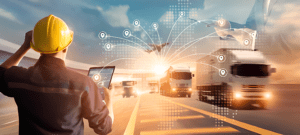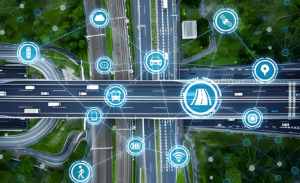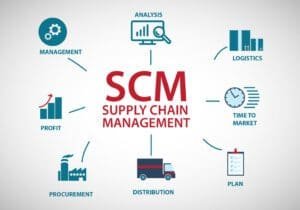I. Introduction
The logistics and transportation sector is a dynamic and vital industry coordinating the global movement of goods, people, and information. It includes many modes of transportation, such as road, rail, aviation, sea, and pipeline, each serving distinct purposes and distances. Logistics services, such as warehousing for storage, coordinated distribution processes, and effective inventory management, play an important role in addition to physical transportation.
Infrastructure is the industry’s backbone, with advanced networks of roads, trains, airports, and seaports supporting the movement of goods and people. Meanwhile, information systems and technology like GPS tracking and supply chain software have become critical for real-time monitoring and optimization of logistical processes.
The sector operates in a complicated regulatory framework that necessitates adherence to numerous security protocols and compliance requirements across diverse regions and countries.

Finally, the logistics and transportation sectors are critical for global trade, connecting enterprises worldwide and promoting economic activity. Its ongoing evolution, spurred by technical advancements and worldwide shifts, shows its crucial role in effectively transferring resources and promoting market interconnection.
See this amazing video related to reole of AI in transport and logistics:
Impact of AI on Various Industries
AI is at the forefront of a new era of technology, reshaping the landscape of numerous industries at a rate never before seen. Its incorporation into several sectors alters existing processes, increases efficiency, and opens up new opportunities. AI is a tremendous force that promotes creativity, from transforming healthcare to streamlining manufacturing. This Introduction delves into how AI fosters innovations, boosts decision-making, and moves companies into the future where artificially intelligent machines are vital to their operations.
Exploring the Transformative Role of AI in Transportation and Logistics
The transportation and logistics business is undergoing a radical transformation due to the revolutionary impact of AI, which is bringing forth new levels of efficiency, precision, and innovation. Important features of the ways AI is making a big difference are these:
- Autonomous Vehicles:
- Drones and self-driving trucks are just a few examples of autonomous vehicles made possible by AI.
- These autonomous vehicles can sense their environment, decide what to do, and adjust to new circumstances with little to no human input.
- The main advantages include decreased accidents, improved safety, and a boost in transportation operations’ efficiency.
- Predictive Analytics:
- Artificial intelligence systems sift through mountains of data in search of trends in customer demand; this aids in optimizing resources and routes.
- Improved supply chain efficiency, less fuel usage, and fewer delays result from better forecasting.
- Warehouse Automation:
- Robots and AI make selecting and packing easier, making inventory management a breeze. – The result is more efficient processing times, fewer mistakes, and better overall handling of items.
- Improvement of the Supply Chain:
- Artificial intelligence (AI) raises the bar for supply chain transparency by revealing real-time shipment status, inventory levels, and interruptions.
- By empowering firms to make data-driven decisions, intelligent supply chain management solutions enhance agility and responsiveness.
- Traffic Management and Route Planning:
- Intelligent algorithms examine current weather trends, traffic patterns, and other real-time data to improve vehicle route planning.
- Logistics can be made more sustainable and efficient by reducing congestion, minimizing fuel usage, and shortening delivery times.
- Customer Experience:
- Personalized services, precise delivery predictions, and real-time tracking are just a few ways AI-driven solutions enhance the customer experience.
- Virtual assistants and chatbots improve communication by quickly answering questions and fixing problems.
- Improving Efficiency and Cutting Costs:
- By enhancing overall productivity, reducing the likelihood of human mistakes, and maximizing the utilization of resources, AI-driven automation lowers operating expenses.
- By utilizing AI-powered predictive maintenance, equipment faults can be better avoided, reducing downtime.
- Environmental Impact:
- Artificial intelligence (AI) helps decrease fuel consumption, optimize routes, and lessen the environmental impact of logistics and transportation operations, all of which contribute to sustainability efforts.

II. The Current Landscape of Transportation and Logistics
Overview of Traditional Methods:
Historically, the transportation and logistics business relied on manual processes, paper-based technologies, and poor visibility into the supply chain. Routing issues, inventory management issues, and communication difficulties were all typical. Human decision-making predominated, often in the absence of real-time data support.
Challenges in the Current Environment:
Complex distribution networks, capacity restrictions, increased customer demands, ecological issues, technology integration complications, regulatory compliance hurdles, and cybersecurity dangers are all part of the contemporary scene. These problems underscore the need for creative solutions to improve the efficiency and effectiveness of transportation and logistics operations.
Key Bottlenecks and Inefficiencies:
- Manual Procedures:
- Challenge: Relying on human data entry, paperwork, and physical tracking results in errors, delays, and inefficiencies.
- Bottleneck: Slow processing times and increased error probability.
- Limited Visibility:
- Challenge: Inadequate real-time visibility into the supply chain impedes decision-making and responsiveness.
- Bottleneck: Inability to manage interruptions and optimize operations proactively.
- Inefficient Routing:
- Challenge: Inefficient route design results in higher fuel usage and longer delivery times.
- Bottleneck: Increased expenses, negative environmental impact, and dissatisfied customers.
- Inventory Management Obstacles:
- Challenge: Periodic manual checks result in inaccuracies and difficulty reacting to changing demand.
- Bottleneck: The risk of stockouts or overstocking reduces supply chain efficiency.
- Communication Barriers:
- Challenge: Fragmented communication among stakeholders delays information flow.
- Bottleneck: Reduced supply chain coordination and response.
Innovation Required to Address These Challenges:
Innovations in these areas have the potential to drastically solve inefficiencies and bottlenecks in the transportation and logistics business, resulting in a more agile, responsive, and sustainable ecosystem.
- Automation and AI:
- Innovation: Using automation and artificial intelligence for route optimization, demand forecasting, and inventory management tasks.
- Impact: Improving overall efficiency by streamlining operations, minimizing errors, and streamlining processes.
- Real-time Tracking and Internet of Things:
- Innovation: Using IoT devices to track real-time shipments and inventory.
- Impact: Increasing visibility, enabling proactive decision-making, and reducing interruptions.
- Advanced Analytics and Predictive Modeling:
- Innovation: Using advanced analytics for predictive modeling and anticipating demand.
- Impact: Resource allocation is optimized, delays are reduced, and supply chain efficiency is improved.
- Digital Communication Platforms 4th.
- Innovation: Implementing digital communication systems for smooth stakeholder collaboration.
- Impact: Improving communication, responsiveness, and supply chain coordination.
- Blockchain for Transparency:
- Innovation: Using blockchain to share data transparently and safely across the supply chain.
- Impact: Increased trust, reduced fraud, and data integrity.
- Warehousing Robotic Process Automation (RPA):
- Innovation: Integrating RPA for warehouse activities such as order processing and inventory management.
- Impact: Processes are being sped up, errors are reduced, and warehouse efficiency is improved.
- Green Logistics and Sustainability:
- Innovation: Adopting environmentally friendly technology and practices to create a more sustainable supply chain.
- Impact: Meeting environmental objectives, lowering costs, and catering to consumer preferences.
III. AI Applications in Transportation
A. Autonomous Vehicles
Self-Driving Technology:
Self-driving technology, also known as autonomous vehicle technology, employs artificial intelligence, sensors, and other technologies to allow vehicles to function autonomously. These cars can independently sense their surroundings, make decisions, and travel routes.

Benefits:
- Increased Safety: Self-driving vehicles are outfitted with robust sensors and algorithms, which reduces the danger of human errors like inattentive driving or exhaustion. Constant monitoring of one’s surroundings enables faster reactions to potential risks, contributing to overall road safety.
- Improved Efficiency: Autonomous vehicles can optimize driving patterns, lowering traffic congestion and increasing fuel efficiency. Communication with other autonomous vehicles can result in smoother traffic flow and shorter commuting times.
- Improved Accessibility: Self-driving technology has the potential to make transportation more accessible for people who cannot drive due to age, disability, or other factors. It has the potential to enable new mobility levels for populations traditionally underserved by public transportation.
- Productivity and Comfort: Passengers in self-driving cars can use their commuting time more productively, working or relaxing. Additional comfort amenities may be added, altering the journey experience.
Current Developments in Autonomous Vehicles:
- Testing and Pilots:
Several organizations, including IT behemoths and automakers, perform substantial real-world testing of autonomous vehicles. Some regions have begun testing self-driving taxis and shuttles.
- Advanced Sensor technology:
Continuous advances in sensor technology such as LiDAR, radar, and cameras lead to improved perception skills for autonomous cars.
- Collaboration and Partnerships:
It is typical for technology corporations, automakers, and startups to collaborate, pooling resources and expertise to accelerate development. Partnerships with ride-sharing businesses for self-driving taxis are being investigated.
Challenges in Autonomous Vehicles:
While self-driving technology holds great promise in safety and efficiency, overcoming these issues is critical for widespread acceptance and integration into mainstream transportation networks. Ongoing study, testing, and collaboration among industry players and regulatory authorities will be critical in creating the future of self-driving vehicles.
- Regulatory Difficulties:
Developing a regulatory framework for self-driving vehicles is difficult, with worries regarding safety requirements, liability issues, and legal responsibilities.
- Technological Limitations:
Adverse weather, complicated metropolitan surroundings, and unexpected circumstances all pose obstacles to current sensor and AI technology.
- Public Perception and Faith:
Developing public faith in the reliability and safety of self-driving vehicles is a crucial challenge. High-profile mishaps with self-driving cars have alarmed potential consumers.
- Ethical Dilemmas:
Ethical programming issues provide complex challenges, such as how the vehicle should prioritize different potential outcomes in an accident.
- Interoperability and Standardization:
A harmonized and safe transportation ecosystem must ensure interoperability and standardization across different autonomous vehicle systems.

B. Predictive Analytics
Applying AI to Forecast Demand:
Artificial intelligence (AI) is crucial in the field of demand forecasting since it uses data analytics and machine learning. Artificial intelligence algorithms can search through mountains of sales data and market trends in search of connections and patterns that would otherwise go unnoticed.
Using machine learning models enhances forecasting accuracy, and systems can adapt and improve their forecasts over time. These models are enhanced by incorporating external data sources like economic indicators and weather patterns, and a more complete picture of the factors impacting demand can be generated. AI-powered real-time updates keep projections adaptable to ever-changing market conditions, allowing for more accurate and timely predictions.
Optimizing Routes and Allocating Resources More Efficiently:
Transportation route optimization and resource allocation are two areas where AI plays a crucial role in achieving greater efficiency. Artificial intelligence (AI) algorithms power predictive analytics, which plan transportation routes by considering weather and traffic patterns.

Artificial intelligence (AI)-enabled dynamic routing algorithms optimized for efficiency and minimized delays by continuously adjusting real-time routes based on the latest information. Intelligent route planning and resource allocation are made possible by the real-time location and performance data the IoT (Internet of Things) sensors integrate into assets and vehicles. By analyzing past route data, machine learning algorithms can determine the best ways to provide resources and make proactive decisions based on hard facts.
Improving Efficiency and Cutting Down on Wait Times:
AI provides many solutions to improve logistics operations, including reducing delays and increasing efficiency. Artificial intelligence (AI)–driven predictive maintenance reduces downtime by identifying when equipment may need servicing. With the help of AI, logistical processes can be monitored in real-time, which helps to spot possible bottlenecks and resolve them quickly. With AI-enhanced supply chain visibility, stakeholders can better coordinate, reducing delays caused by missing information. Combining AI with automated decision-making allows mundane jobs to be made more efficient with fewer human errors and less downtime. With the help of AI, dynamic scheduling systems can adjust their schedules to suit new circumstances, maximizing efficiency while cutting down on delays. Collaborative platforms driven by AI shorten delays caused by misunderstandings by improving coordination and communication among supply chain organizations.
Ultimately, logistics operations, including demand forecasting and route optimization, can be greatly enhanced by strategically implementing AI. A more responsive supply chain, improved operational efficiency, and accurate demand forecasts can help businesses reduce delays and better use their resources.
IV. AI in Logistics Operations
A. Warehouse Automation
The Function of Warehouse Robots Driven by AI:
Warehouses rely heavily on AI-powered robotics to automate various jobs, optimize processes, and boost operational efficiency. Using AI and robotics in these systems allows them to accomplish jobs that humans previously did but with several advantages, such as less overhead and more efficiency.

Advantages of Warehouse Robots Driven by AI:
- Improved Efficiency: Robots driven by AI can work nonstop without rest or breaks, significantly improving their operational efficiency and throughput. Orders are filled more quickly, and lead times are decreased due to efficient movement and task execution.
- Improved Precision: Artificial intelligence-enabled robots can carry out repeated activities with pinpoint accuracy, eliminating human error inherent to such procedures. The precise selection, packaging, and storage of goods in the warehouse are guaranteed by state-of-the-art vision systems and sensors.
- Cost-Effectiveness: The upfront cost of AI-powered robots can be high, but the long-term savings from labor savings, greater productivity, and decreased errors make it a worthwhile investment. Enhanced productivity leads to reduced operating costs and a higher ROI in the long run.
- Adaptability to Variability: Robots can adjust to changes in inventory, order patterns, and warehouse layouts with little to no reprogramming needed, thanks to AI algorithms. – This versatility is particularly advantageous in ever-changing warehouse settings where demands are subject to change.
Case Studies of Effective Applications:
Robotics driven by artificial intelligence has a revolutionary role in warehouses, resulting in faster processing times, more precise results, and lower overall costs. Amazon, Alibaba, DHL, Ocado, and Boston Dynamics are real-world businesses that have successfully integrated these technologies to streamline their warehouse operations.
- Amazon Robotics (Kiva Systems):
Previously known as Kiva Systems, Amazon Robotics currently operates as part of Amazon’s fulfillment centers, doing duties such as moving product shelves to human workers for packaging. Thanks to this update, Amazon’s massive warehouses are far more efficient and quicker to fulfill customer orders.
- The Cainiao Robots System at Alibaba:
To sort, pack, and move packages within its warehouses, Cainiao, Alibaba’s logistics arm, uses a robot system. – The technology has made it easier to handle the increasing number of orders by streamlining operations, decreasing processing times, and improving overall efficiency.
- Robotics at DHL:
DHL uses robotic systems for picking and packing and other duties in the warehouse. These robots work with humans to speed up and improve the precision of order fulfillment.
- The Highly Automated Warehouse at Ocado:
The online grocery store based in the UK, Ocado, uses robots to sort and move goods around in its warehouses. Quick and accurate order fulfillment is made possible by the automated system.
- Stretch by Boston Dynamics:
The Stretch robot by Boston Dynamics is an asset to warehouse operations, excelling in tasks such as material handling and box manipulation. – It can quickly and accurately recognize and handle various objects because of its cutting-edge computer vision and robotic arm technologies.
B. Supply Chain Management
The Effects of AI Throughout the Supply Chain Transparency:
Artificial intelligence (AI) is crucial in improving supply chain visibility from beginning to finish by giving insights and transparency in real-time. Companies can learn all there is to know about the supply chain’s processes, inventory levels, and the whereabouts and conditions of commodities by integrating AI technology. With this increased transparency, we can resolve issues proactively, make better decisions, and work more efficiently.

Data-driven insights for better supply chain management decision-making:
Predictive Analytics: With this information in hand, decision-makers may better plan production timelines, inventory levels, and distribution tactics.
Improved Inventory Management: Artificial intelligence algorithms determine the best inventory levels by analyzing demand trends, supplier performance, and external factors. With this information, decision-makers can keep their supply chains flexible and responsive, cut holding costs, and avoid stockouts.
Routing in Real Time: Artificial intelligence-powered route optimization considers current weather conditions, traffic conditions, and other factors to provide the most effective transportation routes. Shorter lead times, cheaper shipping costs, and happier customers are the outcomes of this data-driven decision-making process.
Managing Supplier Relationships: If you want to When it comes to sourcing strategies, supplier alliances, and risk mitigation, this data-driven approach is key.
Improving the Supply Chain’s Reactivity and Agility:
- Alerts and Real-Time Monitoring:
By utilizing AI, supply chain activities can be tracked in real-time, and any deviations or disruptions may be immediately alerted. Quick resolutions to problems are made possible by this preventative strategy, which lessens the effect on business operations and customer happiness.
- Dynamic Inventory Replenishment:
AI continuously monitors demand changes and adapts inventory replenishment tactics in real-time. Minimizing stockouts and excess inventory; this agile inventory management system guarantees that products are accessible when and where needed.
- Analyzing Potential Scenarios and Simulating the Supply Chain:
With the help of AI, scenario assessments and simulations of supply chains can be built, taking into account various variables and possible disruptions. To make the supply chain more resilient, decision-makers can evaluate the effects of different situations and create backup plans.
- AI-Assisted Order Processing: Artificial intelligence streamlines the order processing process, shortening fulfillment periods and decreasing lead times. – A more rapid reaction to market and consumer demand changes is possible because of the agility that automated operations provide.
In conclusion, artificial intelligence has a revolutionary effect on supply chain visibility from beginning to end, giving decision-makers data-driven insights that improve management of the supply chain as a whole. Businesses may optimize their supply chain operations, respond efficiently to changing market conditions, and decrease risks through enhanced decision-making and increased agility.
V. Case Studies and Success Stories
- Shipment using Autonomous Trucks:
Implementation: Autonomous trucks for long-haul shipping are being tested and deployed by companies such as TuSimple and Waymo.
Benefits: Drivers of autonomous trucks don’t require breaks because the trucks run continuously, which means deliveries are quicker. Companies can save substantial transportation costs through increased fuel efficiency and lower labor costs. AI-powered solutions can make transportation safer by reducing the likelihood of accidents brought on by human variables like exhaustion or distraction.
-
Fleet-Based AI-Powered Predictive Maintenance:
Implementation: Companies like DHL use artificial intelligence to perform predictive maintenance on their vehicle fleets.
Benefits: Thanks to predictive maintenance, which looks at sensor data and past performance, unplanned downtime is minimal. Businesses can save money in the long run by extending the life of their cars and taking care of maintenance issues before they escalate. By keeping cars in top shape for transportation duties, AI-driven maintenance schedules help operations run more smoothly.
Higher productivity, less downtime, improved overall fleet management, saved costs, and increased safety are some tangible benefits of implementing AI in the transportation and logistics industries. These beneficial effects will grow as technology develops, creating a more sophisticated and effective logistics and transportation sector.
VI. The Future of AI in Transportation and Logistics
New AI Developments and Trends in Logistics and Transportation:
- Edge AI and Edge Computing:
Making transportation and logistics decisions in real-time by processing data closer to the source, at the edge.
- AI Robots:
Robots driven by artificial intelligence are becoming more popular for applications such as last-mile delivery, picking, and packing in warehouses.
- Encouraging Blockchain for Transparency:
Integrating blockchain technology may make supply chain processes more transparent, traceable, and secure.
- Digital Twins:
Building asset-specific digital twins that allow for the simulation and real-time monitoring of physical items, such as automobiles or warehousing operations.
- 5G Connectivity:
Using 5G networks to facilitate more dependable and rapid communication among transportation ecosystem devices and systems.
- Maintenance and Predictive Analytics:
Increasing predictive analytics to better anticipate equipment and vehicle maintenance needs, optimize routes, and predict demand.
- Virtual Reality (VR) and Augmented Reality (AR):
Combining AR and VR to improve training, efficiency, and maintenance across logistics operations.
Possible Future Developments and Their Consequences:
- Autonomous Vehicles:
Continuing research and development into and implementation of autonomous vehicles for freight and passenger transportation, consequently changing transportation networks and decreasing dependence on conventional cars operated by humans.
- Supply Chain Orchestration Driven by AI:
State-of-the-art AI systems coordinate all steps of the supply chain, improving workflows and allowing for supply chain management that is both more agile and responsive.
- Ultra-Personalization in Logistics:
Systems powered by AI that offer ultra-personalized logistics solutions, modifying offerings according to each customer’s unique tastes and habits.
- Dynamic Pricing methods:
Algorithms powered by artificial intelligence constantly adapt pricing methods to account for changes in the market, demand, and other factors.
- Green Logistics:
AI is helping to create green logistics solutions, like routes that can reduce carbon emissions and better transportation techniques for the environment.
- Collaborative AI Ecosystems:
The rise of these networks allows various players, including suppliers, manufacturers, and logistics providers, to pool their AI-driven insights to run more coordinated and effective operations.
Artificial Intelligence’s Impact on the Industry’s Future:
How AI develops and is used in the future will significantly affect the logistics and transportation sector. Global supply chain management and the transportation of goods will undergo profound changes due to these innovations, creating a more linked, efficient, and sustainable industry. It will have the following impacts on the industry:
- Artificial intelligence will keep improving logistics and transportation by optimizing procedures and cutting operational expenses.
- Artificial intelligence (AI) will help make practices more sustainable by lowering environmental impact via fuel-efficient operations, environmentally friendly logistical solutions, and optimal routes.
- Business owners can foresee and head off problems, interruptions, and shifts in the market thanks to AI’s more advanced predictive capabilities.
- AI-driven automation and robots will revolutionize last-mile delivery, warehouse operations, as well as other parts of the supply chain.
- A growing trend in the business, data-driven decision-making made possible by AI will enable more informed and precise choices in intricate logistics situations.
- AI will be crucial in enhancing the customer experience with its real-time tracking, swifter and more dependable deliveries, and personalized services.
VII. Conclusion
Efficiency gains, data-driven decisions, and environmental friendliness are all outcomes of implementing AI into the logistics and transportation sector. With the help of AI, supply chain visibility is improved, and operations are optimized. Meanwhile, autonomous vehicles revolutionize transportation.
In the future, we expect to see autonomous vehicles widely used, improved predictive analytics, collaborative AI ecosystems formed, constantly evolving robotics, sophisticated technology integrated, sustainability prioritized, and agility and resilience boosted. AI will drive innovation, efficiency, and eco-friendly practices in the industry.




